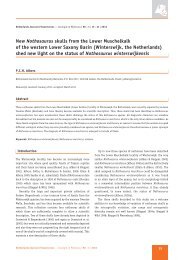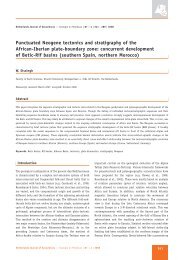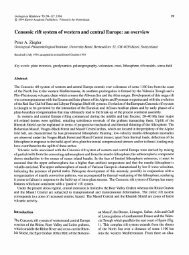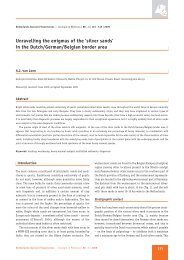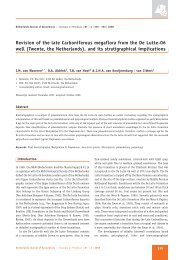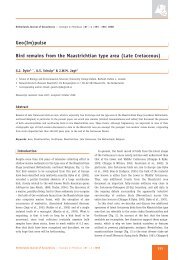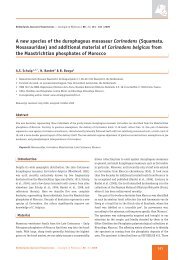Diagnostic sedimentary structures of the fluvial-tidal transition zone ...
Diagnostic sedimentary structures of the fluvial-tidal transition zone ...
Diagnostic sedimentary structures of the fluvial-tidal transition zone ...
Create successful ePaper yourself
Turn your PDF publications into a flip-book with our unique Google optimized e-Paper software.
Fig. 7. Irregular mud-draped<br />
pause planes in X-bedded units.<br />
In <strong>the</strong> uppermost unit oppositely<br />
directed X-bedding is visible in<br />
herringbone X-stratification (see<br />
arrow). Hambach exposure.<br />
a.<br />
b.<br />
c.<br />
Fig. 8. Set-climbing. a. Solitary trains <strong>of</strong> set-climbing ripples. For location,<br />
see Figure 9; b. Alternating large-scale foresets and set climbing;<br />
c. X-bedding entirely made <strong>of</strong> set climbing (Barendrecht exposure).<br />
296<br />
trough area by a temporal weakening or reversal <strong>of</strong> <strong>the</strong> flow<br />
during rising tide. Deposition <strong>of</strong> suspended load during such<br />
periods <strong>of</strong> weak currents probably contributes to <strong>the</strong> thickness<br />
<strong>of</strong> <strong>the</strong> bottomsets, which in places reaches several decimetres<br />
in thickness. As is shown in Figure 9 <strong>the</strong> foresets <strong>of</strong>ten display<br />
a knicked, ‘shovel’ appearance as <strong>the</strong>y pass into such extensive<br />
bottomsets. Similar shovel-toe foreset to bottomset assemblages<br />
and set-climbing features have been described from a supposed<br />
<strong>fluvial</strong>-<strong>tidal</strong> <strong>zone</strong> in Permian deposits <strong>of</strong> central India (Gosh et<br />
al., 2005).<br />
Shovel-toe bottomsets are not restricted to <strong>the</strong> <strong>fluvial</strong>-<strong>tidal</strong><br />
<strong>zone</strong>. They can also be found in purely <strong>tidal</strong> deposits. Here,<br />
<strong>the</strong>y are laterally associated with intervals <strong>of</strong> thin bundles.<br />
This indicates that <strong>the</strong> thick bottomset intervals correspond<br />
to neap tide conditions, when dune height decreases and <strong>the</strong><br />
dune trough is partly filled in (Van den Berg, 1982). Thick<br />
bottomsets in <strong>tidal</strong> deposits can be distinguished from <strong>the</strong>ir<br />
counterparts in <strong>the</strong> <strong>transition</strong>al <strong>zone</strong> by a much better organization.<br />
Instead <strong>of</strong> a disorder in directions a regular vertical<br />
alternation <strong>of</strong> flood and ebb directed x-lamination is present<br />
(De Mowbray & Visser, 1984). The above evidence suggests, that<br />
thick bottomset layers are related to decelerating flow conditions,<br />
ei<strong>the</strong>r in time (neap-spring tide cycles), or space (upper<br />
point bar conditions in <strong>the</strong> <strong>fluvial</strong> domain). As bottomsets<br />
consist <strong>of</strong> fine-grained sand transported as suspended load,<br />
<strong>the</strong>y can only be formed if appreciable amounts <strong>of</strong> fine sand<br />
are available and if a strong vortex movement does not prevent<br />
its sedimentation. In <strong>the</strong> <strong>fluvial</strong>-<strong>tidal</strong> <strong>transition</strong> <strong>zone</strong> both<br />
conditions are fulfilled: fine sand is generally available in large<br />
quantities and flow energy is moderate. The prerequisite condition<br />
<strong>of</strong> a non vigorous vortex movement is supported by <strong>the</strong><br />
fact that in literature thick dune bottomsets have never been<br />
reported in conjunction with foresets <strong>of</strong> very coarse sand and<br />
fine gravel: dunes <strong>of</strong> this material can only exist in relatively<br />
strong flow conditions, impeding <strong>the</strong> settling <strong>of</strong> fines in dune<br />
troughs.<br />
Ne<strong>the</strong>rlands Journal <strong>of</strong> Geosciences — Geologie en Mijnbouw | 86 – 3 | 2007



